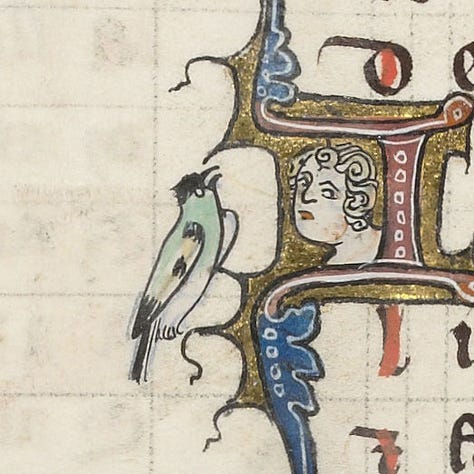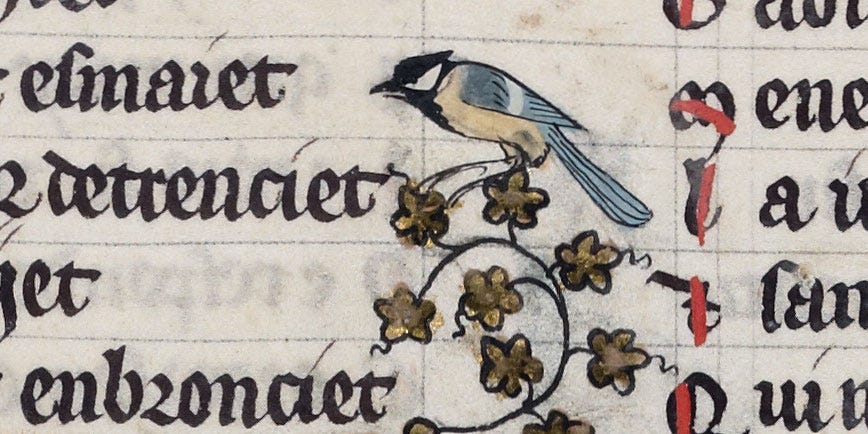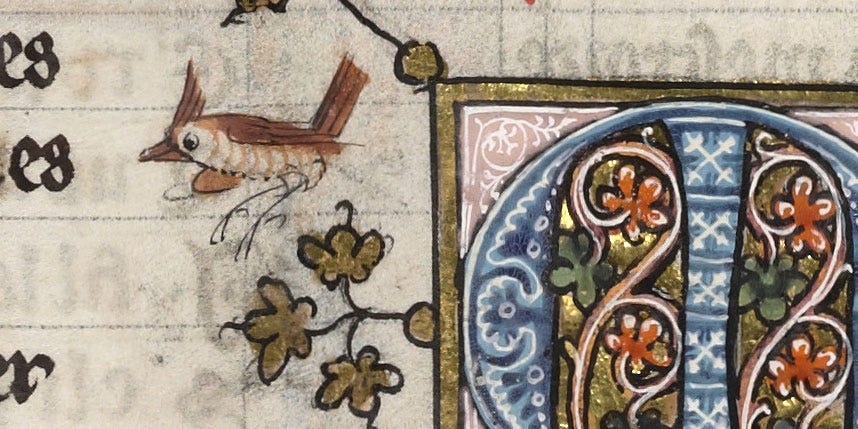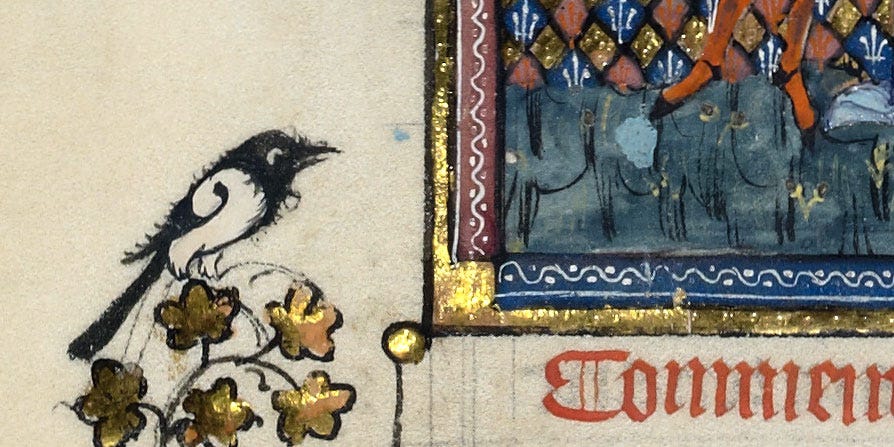I was planning to next publish the last planet of Heavenly Figures: Saturn, but as appropriate as that would have been, I feel what we need right now is a reminder the world is still full of delightful things – and forgetting about them makes it easier for the darkness to sweep them away.
A few days ago, while perusing illuminated manuscripts of the Bodleian, I came across a medieval French romance alive with birds. Not generic birds, but tenderly-observed, identifiable species, revealing a closeness and attentiveness to nature that is now the exception rather than the norm. So I went and picked out as many as I could find, to inspire and delight.
All images are from the digitised version of Oxford, Bodleian Library MS. Bodl. 264.
This beautiful volume dated 1338-1344 was made in Flanders and illustrated by Jehan de Grise. It’s a complete Alexandre cycle (Roman d’Alexandre and others), written in French that is quite legible if one has the time, but my focus was squarely on the feathered critters that abound on every page.
Without further ado, let’s zoom in on some of the hundreds of birds that animate this text. As the language is French, I’m including their French names before the Latin name, because why not. Some of these identifications are tentative, and I’m open to corrections!
Birds Known
Goldfinch (Chardonneret élégant, Carduelis carduelis), male and female:
Bullfinch (Bouvreuil pivoine, Pyrrhula pyrrhula):
Great tit (Mésange charbonnière, Parus major):
Blue tit (Mésange bleue, Cyanistes caeruleus):
Long-tailed tit (Mésange à longue queue, Aegithalos caudatus):
Song thrush (Grive musicienne, Turdus philomelos):
Jay (Geai des chênes, Garrulus glandarius):
Eurasian wren (Troglodyte mignon, Troglodytes troglodytes):
Barn swallow (Hirondelle rustique, Hirundo rustica):
It may be a stretch to see the below as distinct to the above, the artist could have simply not gotten around to adding the red, but it could be: House martin (Hirondelle de fenêtre, Delichon urbicum):
Common magpie (Pie bavarde, Pica pica):
Jackdaw? (Chouca, Coloeus monedula):
Collared dove (Tourterelle turque, Streptopelia decaocto):
Common cuckoo (Cocou gris, Cuculus canorus):
Common kingfisher (Martin-pêcheur d'Europe, Alcedo atthis):
Black-crowned night heron (Bihoreau gris, Nycticorax nycticorax):
Hoopoe (Huppe fasciée, Upupa epops):
Sparrow:
What struck me as odd is the complete absence of one highly familiar bird, the European robin (Rouge-gorge familier, Erithacus rubecula). I wonder if the following could possibly be meant to represent him, but the fact the red doesn’t cover the face may rather point to the common linnet (Linotte mélodieuse, Linaria cannabina)
Quails (Cailles):
Owls, including a fluffy chick:
Common rosefinch? (Roselin cramoisi, Carpodacus erythrinus)
Fieldfare? (Grive litorne, Turdus pilaris):
White Stork (Cigogne blanche, Ciconia ciconia):
How lovely is this scene!
Here we also get a glimpse of falconry, a practice so important that the symbol for the month of May in Northwest Europe is a falcon on the hand:
Here are various falcons and other small birds of prey, though it’s quite hard to identify them precisely:
Parakeets turn up rather early:
Then again so do peafowl; being native to India didn’t stop them from becoming part of ancient Greek myths and early Christian symbology, so they were clearly circulating.
Birds unknown
I haven’t been able to identify these birds, and it’s possible they are, like the peacock, more exotic birds, or even fantasy ones. It’s only after uploading that I realised the first one could be a skylark (alouette des champs, Alauda arvensis)…















If you recognise any of them, please let me know!
Birdsong
Nothing in this volume touched me as much as realising that the delicate tendrils and flourishes blossoming from some of the birds’ beaks were a visual expression of birdsong... So that the text is full of sound, as well as colour.
Other and unexpected
I’m not going to make this much longer, but wanted to share this unexpected scene of chasing butterflies…
And finally a stag that looked rather unimpressive at first sight:
Until a closer look reveals it’s a man in a stag suit…
And here’s a proper stag, to give the artist his due.






































































I love birds. Thank you for the beautiful share! Birdsong and all! Lovely way to start my day.
Fascinating and beautiful! Thank you for a look into these lovely paintings—they are most definitely an inspiration and a delight ✨